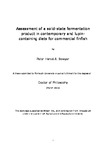Assessment of a solid-state fermentation product in contemporary and lupin-containing diets for commercial finfish
| dc.contributor.supervisor | Merrifield, Daniel | |
| dc.contributor.author | Bowyer, Peter Hervé A. | |
| dc.contributor.other | School of Biological and Marine Sciences | en_US |
| dc.date.accessioned | 2016-10-18T10:14:33Z | |
| dc.date.issued | 2016 | |
| dc.identifier | 10139246 | en_US |
| dc.identifier.uri | http://hdl.handle.net/10026.1/6555 | |
| dc.description | This research was completed with financial contribution from Exmoor Fisheries | en_US |
| dc.description.abstract |
This body of research explores the dietary application of a bioactive, solid-state fermentation (SSF) product in contemporary and lupin-containing diets of Nile tilapia (Oreochromis niltoticus) and rainbow trout (Oncorhynchus mykiss). Consequently, the work provides holistic assessment of the influences of SSF products on animal health and performance; depending upon rearing temperature, nutritional physiologies, feed formulations and extrusion conditions; alongside information on the performance of lupins in aquafeeds. The SSF product (at 0.1 % inclusion) improved growth performance of Nile tilapia fed diets containing lupins. Phosphorous retention appeared higher when the SSF product was included in a yellow lupin (Lupinus luteus) diet whilst Mg retention was significantly higher in fish fed narrow-leaf lupin (Lupinus angustifolius). The experimental ingredients did not appear to show any clear effects upon midgut macrostructure. At an ultrastructural level, the fish fed yellow lupin alone, displayed poorest brush border characteristics but those fed yellow lupin and the SSF product showed signs of amelioration since they did not differ significantly from those fed narrow-leaf lupin. Focus was then turned towards a yellow lupin-based diet in rainbow trout, with two inclusion levels of the SSF product. The SSF product significantly improved growth performance and feed efficiency at 0.5 %, with values closer to a fishmeal-based diet than the lupin control. The SSF product increased the digestibility of protein and energy and bioavailability of numerous elements. However, the digestibility and bioavailability of certain nutrients, e.g. fibre and Zn, were only increased with a 0.5 % inclusion. The SSF product influenced vertebral Ca:P ratio but no effect on vertebral morphology was identified. Fish fed yellow lupin kernel meal displayed high Mn concentrations throughout a number of tissues. The intestinal environment was explored in depth, revealing large differences dependent upon SSF product inclusion rate. Fish fed a 0.1 % inclusion exhibited deteriorated brush border characteristics and high diversity of microbes, including increased proportions of key salmonid pathogens. Those fed a 0.5 % inclusion displayed signs of increased surface area at an ultrastructural level, reduced goblet cell numbers and a low microbial diversity; with domination of one particular family, Enterobacteriaceae. Activities of alkaline phosphatase and leucine aminopeptidase within the anterior intestine also appeared to be influenced by SSF product inclusion. Variations in haemato-immunological parameters were also observed between the treatments. In the final experiment, the SSF product was applied, pre-extrusion, to a contemporary rainbow trout formulation, at 0, 0.5, 1.0 and 1.5 %. No significant improvements to performance were identified following SSF product inclusion. However, crude protein digestibility from SSF-supplemented diets was significantly higher than the control and tendencies towards elevated retention of Ca, P, and Mg were apparent. In vitro analysis of free-phosphate release was conducted upon pre- and post-extruded diets, at varying temperatures. This indicated that neither extrusion conditions (105 °C) nor an ambient temperature of 10 °C were sufficient to cease P-liberating capabilities by the SSF product; suggesting that the two conditions combined limited the product’s efficacy in practice. This research evidenced that SSF products can be an effective means of improving the available nutrient profiles of compound diets for both omnivorous, warmwater and carnivorous, temperate finfish. Lupins are a promising alternative protein source but their nutritional value can be substantially improved by SSF product application. Exploration of the effects of SSF products on the intestinal environment revealed that both negative and positive effects on intestinal health can occur, which is highly dependent upon product inclusion rate. The holistic approaches adopted within this series of studies have seldom been performed on monogastric animals and thus provide valuable, transferable information for advancing knowledge in the application of SSF products, exogenous enzymes and lupins to farm animal feeds, in general. | en_US |
| dc.description.sponsorship | Alltech, Innovate UK (Lupins in UK Agriculture and Aquaculture) | en_US |
| dc.language.iso | en | en_US |
| dc.publisher | Plymouth University | en_US |
| dc.subject | Aquaculture | en_US |
| dc.subject | Rainbow trout | en_US |
| dc.subject | Tilapia | en_US |
| dc.subject | Alternative protein | en_US |
| dc.subject | Exogenous enzyme | en_US |
| dc.subject | Fish nutrition | en_US |
| dc.subject | Aquafeed | en_US |
| dc.subject | Intestine | en_US |
| dc.subject | Gut | en_US |
| dc.subject | Digestibility | en_US |
| dc.subject.classification | PhD | en_US |
| dc.title | Assessment of a solid-state fermentation product in contemporary and lupin-containing diets for commercial finfish | en_US |
| dc.type | Thesis | |
| plymouth.version | publishable | en_US |
| dc.identifier.doi | http://dx.doi.org/10.24382/1555 | |
| dc.identifier.doi | http://dx.doi.org/10.24382/1555 | |
| dc.rights.embargodate | 2017-04-18T10:14:33Z | |
| dc.rights.embargoperiod | 6 months | en_US |
| rioxxterms.funder | Not available | en_US |
| rioxxterms.identifier.project | Not available | en_US |
Files in this item
This item appears in the following Collection(s)
-
01 Research Theses Main Collection
Research Theses Main


